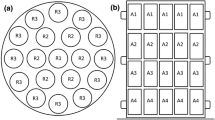Abstract
In this work, we calculated neutron dose buildup factor at energy interval 80–120 MeV for the calcareous type of ordinary concrete (i.e., one made of sand and aggregate composed basically of limestone) using the data from the literature and an improved empirical fitting formula for estimating neutron buildup factors. We could estimate the removal macroscopic cross section of neutron (Σ R ) in this range of energy (80–120 MeV) at various mass thicknesses (0 < X < 550) for this type of concrete. The results are compared with the Monte Carlo method.




Similar content being viewed by others
References
Chilton AB, Shultis JK, Faw R (1984) Principle of radiation shielding. Prentice Hall, Englewood Cliffs. ISBN 0-13-709907X
Duderstadt JJ, Hamilton LJ (1976) Nuclear reactor analysis, Copyright c by Wiley. ISBN 0-471-22363-8
Durani L (2009) Update to ANSI/ANS-6.4.3-1991 for low-Z and compound materials and review of particle transport theory. Master of Science thesis, University of Nevada, Las Vegas
Fernandes JCL, Borges V, Vilhena MT, Bodmann BE (2011) Determination neutron buildup factor using analytical solution of one-dimensional neutron diffusion equation in cylindrical geometry. 2011 International Nuclear Atlantic Conference-INAC 2011 Belo Horizonte, MG, Brazil, ISBN: 978-85-99141-04-5
Fernandes JCL, Vilhena MT, Bodmann BE, Borges V (2013) On the build-up factor from the multi-group neutron diffusion equation with cylindrical symmetry World. J Nucl Sci Technol 3:1–5
McMillan JE (2008) Neutron shielding for particle astrophysics experiments. University of Sheffield. arXiv:physics/0510186v1
Schaeffer NM (1973) Reactor shielding for nuclear engineers, p 626
Sekimoto H (2007) Nuclear reactor theory. Tokyo Institute of Technology (COE-INES), ISBN978-4-903054-11-7 C3058
Shin K, Ishii Y (1992) Buildup factors for medium energy neutrons up to 400 MeV. Radiat Prot Dosim 40(3):185–199
Shin K, Kotegawa H, Sakamoto Y, Nakane Y, Nakashima H, Tanaka S (1997) Point isotropic buildup factors of medium energy neutrons for concrete, iron and a double layer of iron followed by concrete. Radiat Prot Dosimetry 71:269–278
Shirani A, Shahriari E (2007) Determination of neutron dose-equivalent buildup factors for infinite slabs irradiated by point isotropic neutron sources using the MCNP code. J Sci Islam Repub Iran 18:177–180
Shultis JK, Faw RE (2005) Radiation shielding technology. Health Phys 88(4):587–612
Soklaski R (2009) A study of neutron shielding methods for experimental astrophysics. NSF/REU Program Physics Department, University of Notre Dame
Turner JE (2007) Atoms, radiation, and radiation protection. ©2007 WILEY-VCH Verlag GmbH & Co. KGaA, Weinheim. ISBN 978-3-527-40606-7
Walker RL (1961) A summary of shielding constant for concrete. Michigan School of Mining and Technology, ANL-6443
Author information
Authors and Affiliations
Corresponding author
Rights and permissions
About this article
Cite this article
Salehi, D., Sardari, D. & Jozani, M.S. Computation of Neutron Dose Buildup Factors for Ordinary Concrete in the Fast Range of Energy: A Comparative Study. Iran J Sci Technol Trans Sci 42, 927–931 (2018). https://doi.org/10.1007/s40995-018-0492-1
Received:
Accepted:
Published:
Issue Date:
DOI: https://doi.org/10.1007/s40995-018-0492-1




